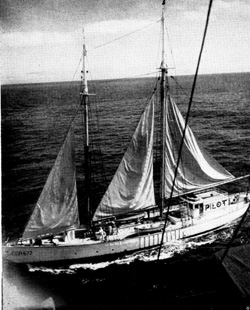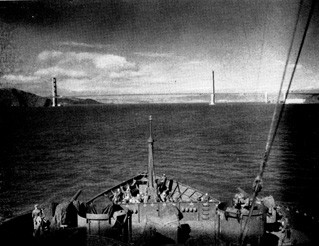Chapter XIV
Victory
AFTER our 82nd combat landing at Macajalar Bay in the northern part of Mindanao, it became apparent that we would have no more amphibious landing in the Philippines. It became obvious that our next big job would be the landing we had all anticipated for many months - the landing on Japan.
Early in June, General Heavey along with the commanders of the two other amphibian brigades in the Philippines, the Third under General Ogden and the Fourth under General Hutchings, attended a planning conference at GHQ at Manila. There our part in the coming landing was threshed out in detail. As usual, old 2 ESB would be needed 100 percent. When the general returned, he was tight lipped as to when and where the landing would occur but he did say that the entire brigade would be committed with the Sixth Army in the initial landing and that a regiment of the 4th Brigade would be attached to us for the landing as four regiments would be required for the job assigned to us. He also did bring the news that there was still time for a large number of the members of the brigade to get a 45-day tour of temporary duty in the States and get back for the landing. Those lucky enough to get in on these details left by plane or ship for their "Three R's" in the States; rest, relaxation, and recreation as the orders read. They deserved it but it was sad that many more in the brigade who also deserved it could not go due to lack of shipping and time. In addition to those who left on the "three R's," a large number who had over 100 points soon found themselves homeward bound for discharge or reassignment to units in the States.
Pleas were made to higher headquarters for replacements to fill us up to full strength for the coming operations. The respect with which we were regarded at GHQ and the realization that the doughboys could not land on the surf-swept shores of Japan unless we were there to help land them and to keep the necessary supplies and reinforcements rolling over the beaches to them, led to prompt action. In late July over a thousand new men intended for the infantry arrived to join the brigade. They were a very welcome edition to the brigade and seemed to be glad they were joining us Amphibs, and entitled to don the blue and gold shoulder patch of Combined Operations.
 Pilot boat meets transport off Golden Gate Pilot boat meets transport off Golden Gate
The next few weeks were spent in reassembling our scattered units and in training and absorbing the new men as well as in readying our equipment for the coming invasion. The 532d assembled first on Mindoro where the regimental headquarters had been located since the initial landing on December 15, 1944; then it moved on to Panay to train with the division with which it was to land. The 542d concentrated on Cebu. Its main city of the same name before the war had been known as "Little Manila" but now was a sad ruin much like Manila. After its numerous landings along the coasts of Luzon from Bataan and Corregidor to as far as 300 miles north of Legaspi, the 592d gradually assembled at Batangas on the southern shore of Luzon. The 562d Boat Maintenance Battalion still had its headquarters on the protected waters of Cancabato Bay in northern Leyte. Most of the Brigade Special troops were a few miles south at San Roque, but the advanced echelon of Brigade Headquarters had moved up to Luzon to be near the Headquarters of the XI Corps with which it had much detailed plans to work out.
 Back Home ! Back Home !
About the first of July word drifted in from Guam that the B29 pilots were betting that the war would end before the first of September. We on the Philippines were skeptical. We thought it was some more of the Air Force's claims that they could end the war by bombing alone. We thought an invasion would be necessary to bring the Japs to their knees. The Air Force could not crush Germany by bombs; certainly the Japs would take the bombing more fanatically than the Germans. No, we agreed, it will take a landing on real Jap soil to convince them that they were defeated. Preparation and training went ahead full speed.
Then in early August came the astounding news that a single atomic bomb had been dropped on Hiroshima. Reports claimed it was two thousand times as powerful as TNT. Soon aerial photos confirmed that the destruction in Hiroshima was as terrific as the claims of the atomic bomb indicated. How could the Japs now continue the war? All suddenly changed their viewpoints. Certainly a combat landing would not be necessary now. The declaration of war by Japan and the dropping of a second atomic bomb on Nagasaki followed in rapid succession. Then came the flash that Japan was seeking terms of surrender. After exasperating delays the Japs finally surrendered at 1900 (EWT) August 14. It was one thousand one hundred and fifty-one days since the Brigade had been born at Camp Edwards, Massachusetts. It had been a long war for us with almost a thousand days overseas and more to follow for most of us.
We joined the other American troops in the Philippines in the celebration of the end of the war. It had been a long, long trip from Cape Cod to Luzon via Carrabelle, Fort Ord, Australia, New Guinea, New Britain, and the many islands of the Philippines. We had never faltered. Many a silent prayer went up to God that our fighting days were over. Thoughts of those comrades who were missing, who had made the final sacrifice for their country and for us saddened us and made us resolve that in the peace to come they would never be forgotten.
As this History of the Second Engineer Special Brigade goes to press, we do not know whether we will be included in the Army of Occupation to go on to Japan or whether, as the oldest amphibian brigade in the Pacific area, we will be returned to the States direct from the Philippines. This a fitting time to close our tale. Every member of the Brigade, wherever he is; in the Philippines, in Japan, or home - can be proud of the fact that he was a member of 2 ESB, a unit that always did its job no matter what difficulties were encountered in its new field of amphibious warfare.
Well Done, Ye of the Second Engineer Amphibian Brigade
|